first published 01 Jul 2024
Caution! This article may make you cringe.
My Socket 462 board died! :( It was an MSI KT3 Ultra, a fine, red-colored KT333 DDR board, one that I - ironically – ignored and reduced to an afterthought of being “another random board in stock”; couldn’t seem to find a use for it until I did, and had so with a huge desire, but by then, I didn’t get much life out of it. It came into my possession as part of a deal; the board – along with a couple of PCI-X SCSI cards – were in a case I had bought on classifieds. Frankly, I had no need for a board like this at the time, but removing it and the peripherals from the case while at some stranger’s house is less-than-stellar idea for the sake of time, if only, so it stayed – and later on was delegated to a box along with other “random boards”. I checked it, but it didn’t POST so I didn’t bother. The case, meanwhile, became the Slowbox – a trusty, albeit simple and crummy P4 WinXP box that helps out in managing my other retro PCs.
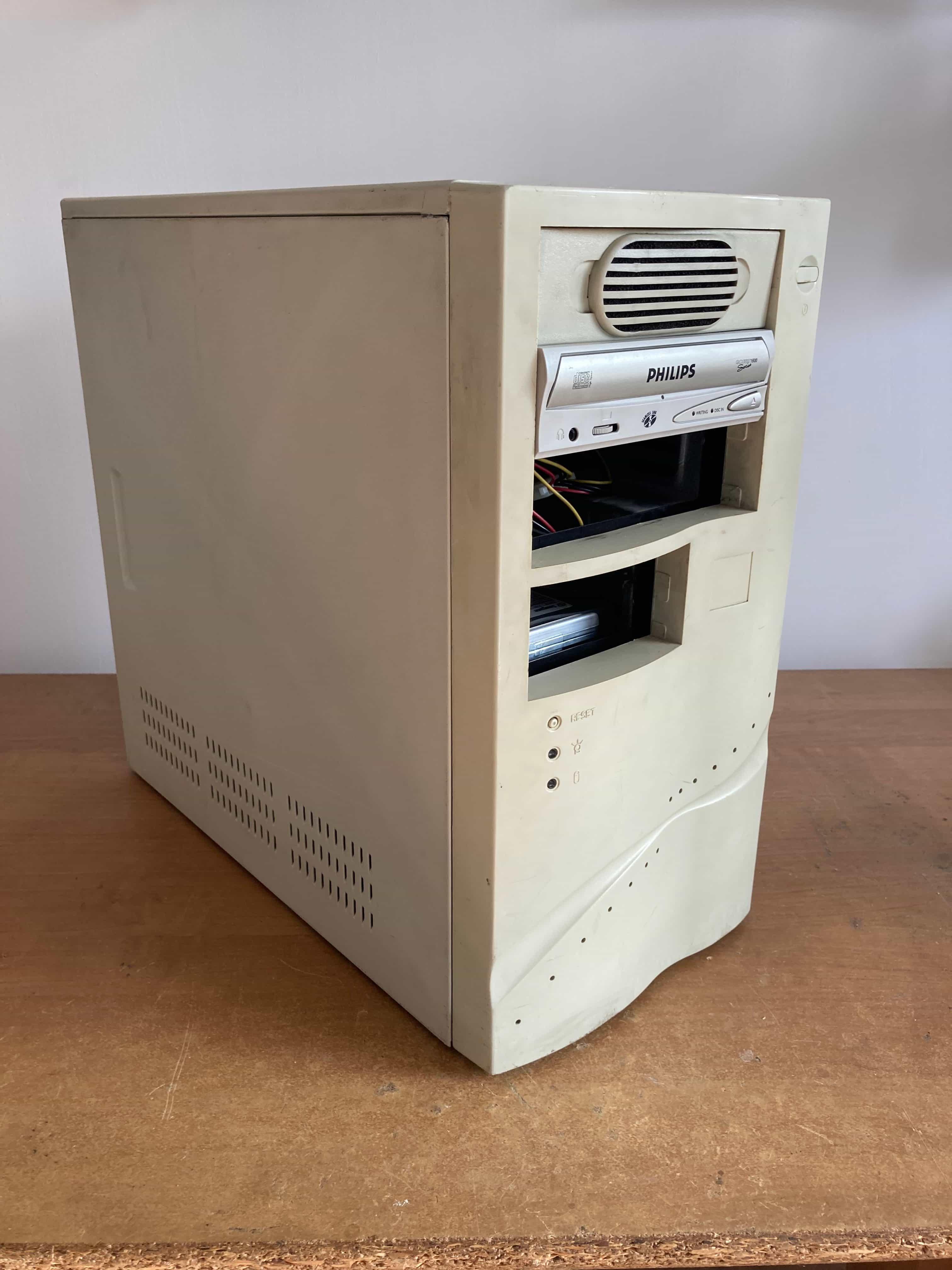
The Slowbox. You can read more about it here.
Fast forward to fall of 2023, in the midst of me spending all of my spare time on retro PCs – benchmarking, building, playing with software to create some “solid” builds I wouldn’t open every 2 weeks (as if, haha!) – I realized that the Pentium 3 PC I am so proud of was indeed Y2K ready, but… not much more. Games such as Deus Ex, Hard Truck 2 or NFS: Porsche Unleashed are playable, but let’s not sugarcoat – in games such as these, framerates hovering around the 20fps mark, frequent drops and odd graphics quality (see below) is rather unsatisfactory – say, for example, trying to snipe a running NSF agent with a tranq dart while the screen is all choppy is infuriating. There might be some clues as to why – while much more pleasant than the TNT2 M64, the 32MB Radeon VE with its 64-bit bus is still a meh card (I had thought I was getting the “real” one!); in addition, I some of the drops seem to in fact be lags that are possibly related to the HDD. The Pentium 3 PC requires another look into the hardware department, but at the same time, I was faced with the perspective which I came to really enjoy – building a 2001-2003 or so PC that could cough up enough computing power to play the aforementioned games (and more, of course) more comfortably.
Let the record reflect: I might need another build!
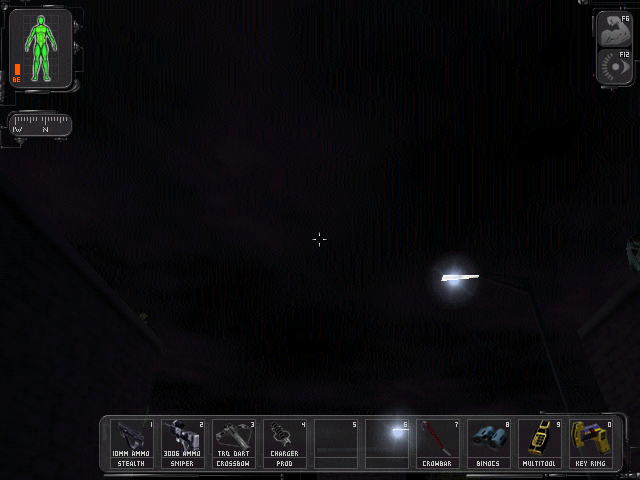
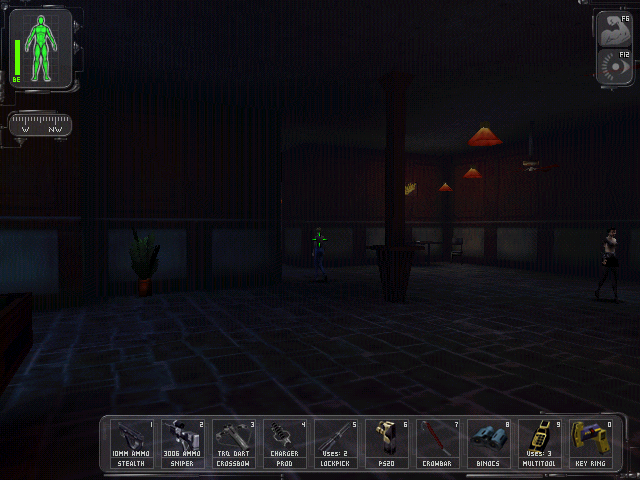
While it may be hard to see on a high-resolution display, the odd dithering is very noticeable on a CRT. In addition, the card displays a relatively low contrast spec - at times irksome with a game such as Deus Ex.
I say that because while it would be rad to have a 1000MHz CuMine, I don’t have one (much less a rad GPU, but more about that a bit later). That, and the current specification perfectly suits me for all the other games from the time period I had envisioned for the build. Sure, I could use the Slowbox, and I did so for a time; however, this setup is balls-basic (not that big of a fan of the Celeron D, ya dig), plus you can guess that I like more period-specific builds, so promptly I remembered about the poor red Socket 462 board and out went the Celeron.
Luck hasn’t been kind to me when it comes to certain motherboards over my retrocomputing journey – most particularly, Socket 3 ones (the first one I ever obtained is a real horror story. I hope to frame the board and hang it on the wall someday), and Socket A/462 mobos. Way back when, in the late Vista days, I remember messing around with a Socket 462 computer in a nice, beige ATX case – back then we only had one computer to share with my two brothers, so for a nerd like me, even a dated PC and a CRT made me fall head over heels with the thing. Tinkering, installing OSes, games, running around with LAN cables… fun stuff! Still hunting for the case – it’d be great to come back to making a setup sorta like that! I also remember it being kind of… unstable – it would BSOD a lot, hang, that sort of stuff… the memories are foggy and the instability may well be the case of PEBKAC, particularly in the driver department, though ultimately, the board stopped POSTing. The only thing that remains is the Duron CPU. I then got another one somewhere around 2017 which was DOA, and by that time I dove into mid-to-late-90s retro computing and gaming, so I didn’t pay much attention. Now, as I got to the board in question, what I knew about the MSI Socket 462 board, along with the previous boards, brought some mixed feelings – echoes of failed experiences meshed together with the excitement of a new build – and some troubleshooting work that I love.
One Friday afternoon I dug out the MSI Socket 462 board and tried to remember what exactly was the state of it. All I remember was that it didn’t boot, and a closer inspection located a corroded spot on the board’s Winbond Super I/O chip. It seemed to be OK, but one brush and the leg snapped in half.
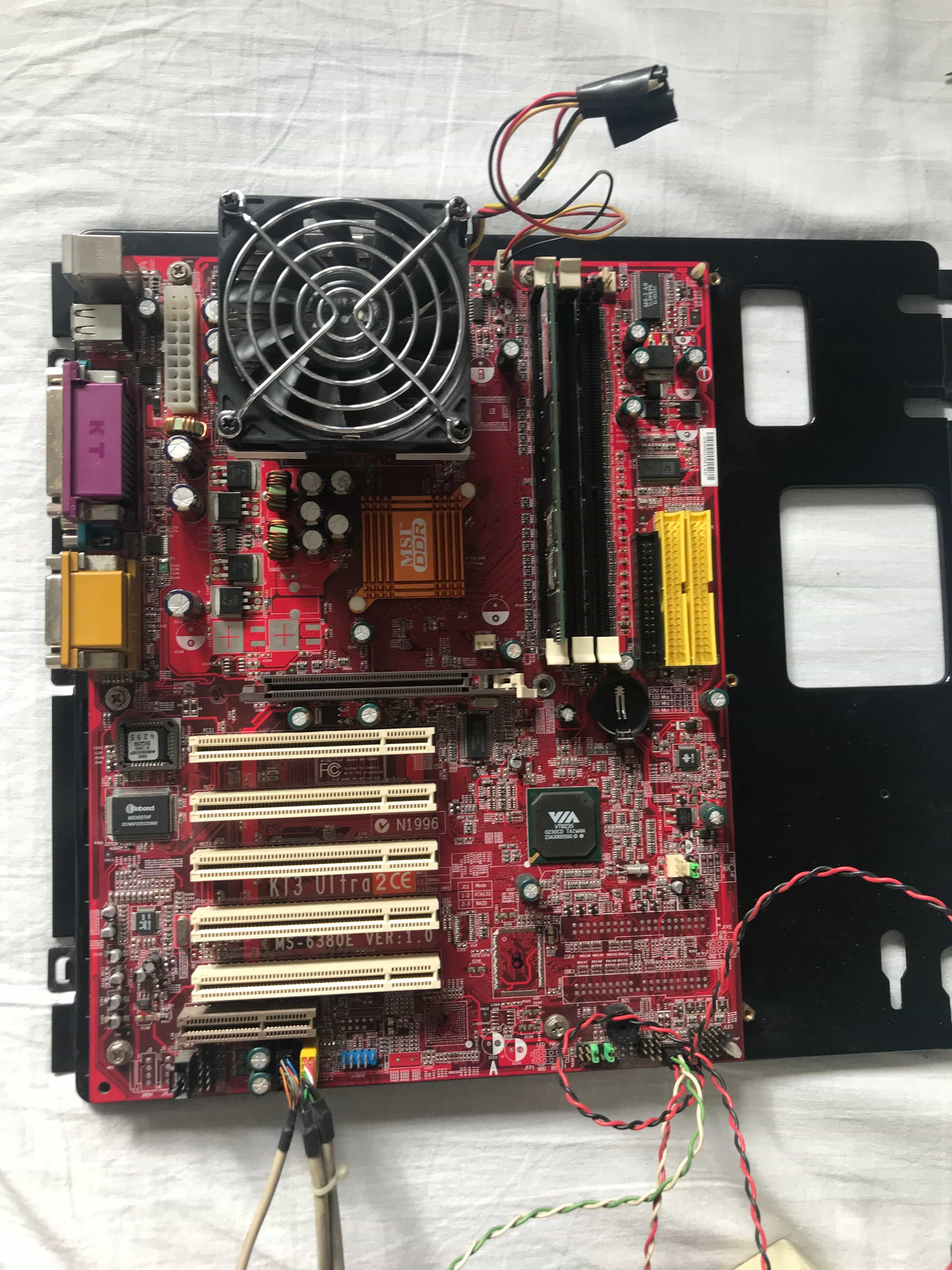
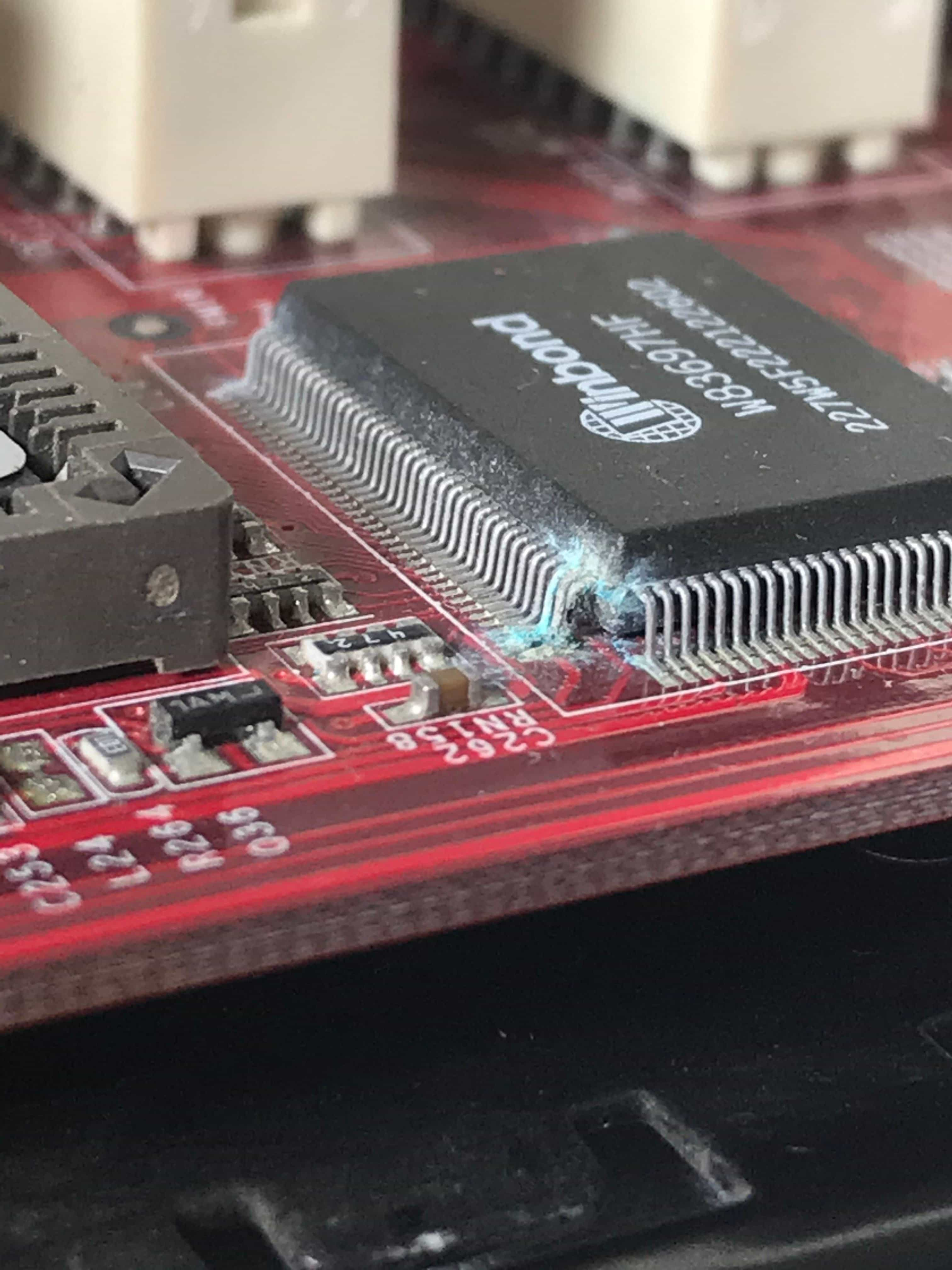
Luckily, it wasn’t my first rodeo, so after a clean I managed to solder a small-gauge piece of wire to the stump and after checking with a multimeter I proceeded further. The board came with a CPU and a cooler (with a badly-spliced fan cable held together with a BAND-AID and scotch tape, but whatever), and underneath it lay an Athlon XP 1800+ which was a nice surprise! The thermal grease was reapplied, and the cooler checked – it worked OK, pretty smoothly. Even the northbridge got its thermal grease sorted out. I did find one capacitor that looked a bit worn down from the top, but it wasn’t bulged – granted, the year of the board fits in the capacitor plague era, though by this time likely all bad caps would’ve been visible (and felt on first boot). Finding a DDR stick was no problem, and since the board does not have onboard graphics, all that was left was a nice GPU. For the purposes of testing, I got the ol’ TNT2 M64 and a D-Bracket, which is a rear bracket equipped with USB ports and a special 4-LED display that is able to display error codes upon POST in red-green combinations of lights. It requires a special connector on the motherboard so I think it was just a MSI thing. Neat tool. The board POSTed! It complained about a damaged fan (surely because of the hack job done to the cooler), wailing high and low – luckily this setting could be disabled in BIOS. Other than that, it was fine!
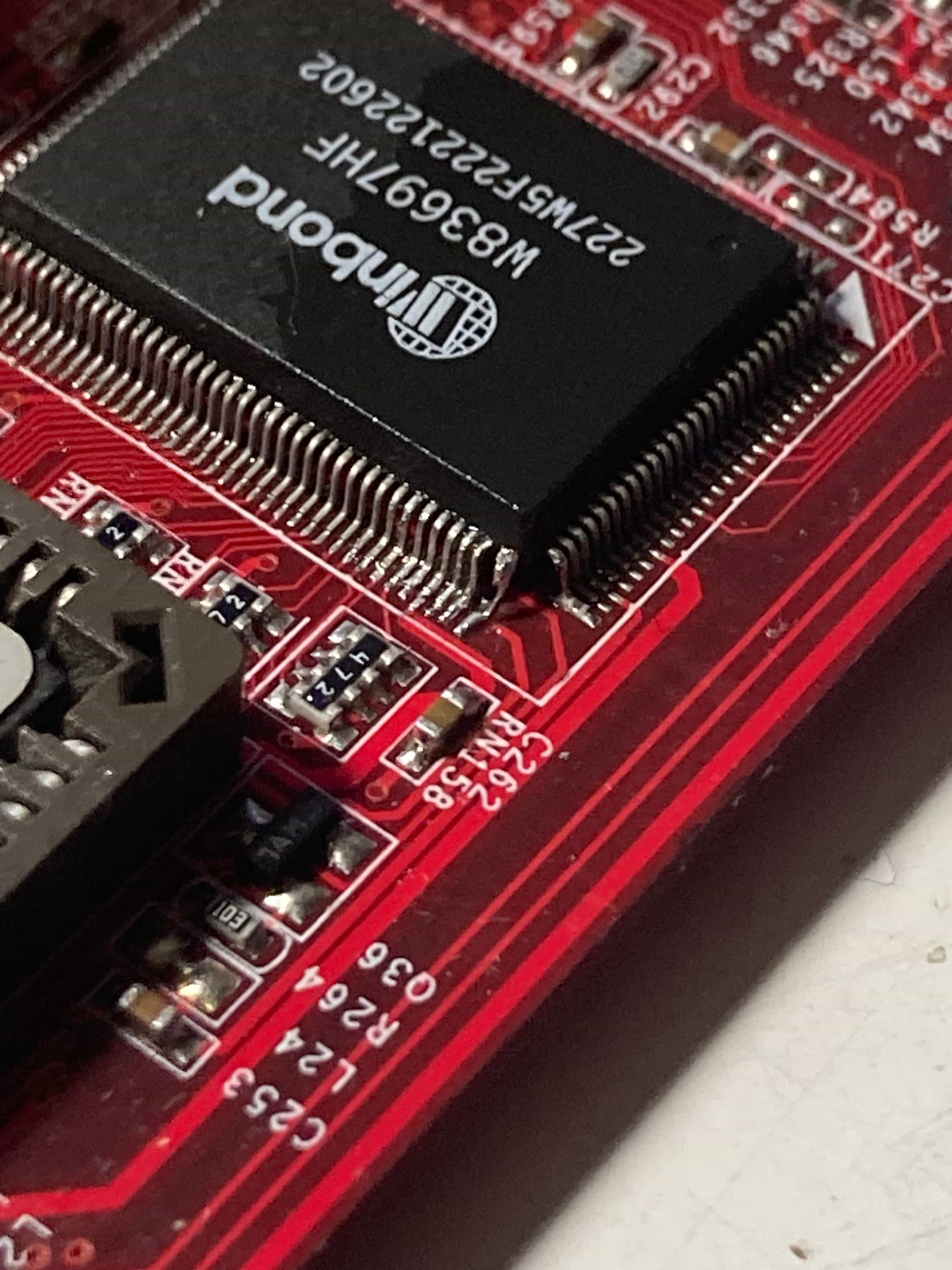
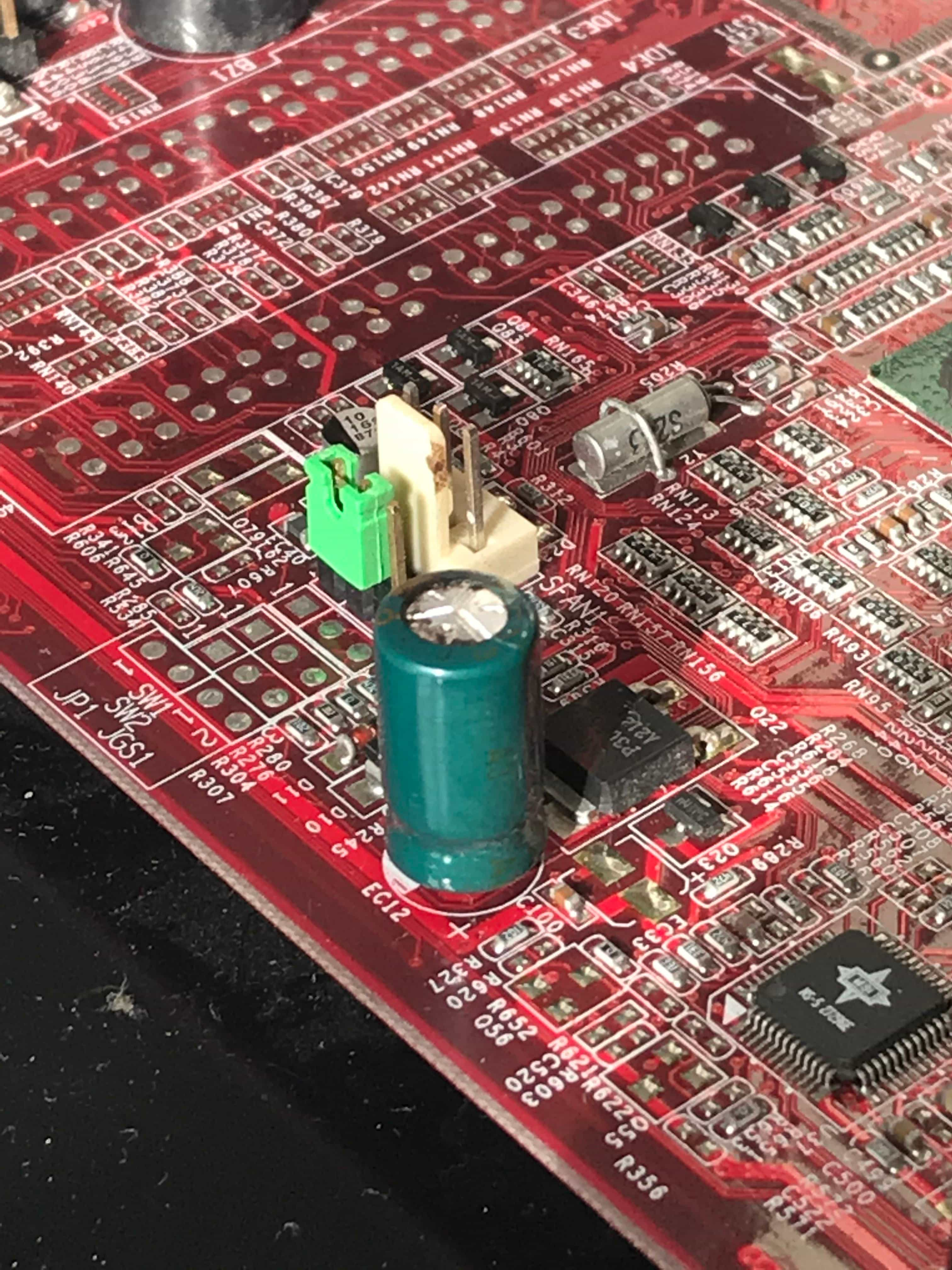
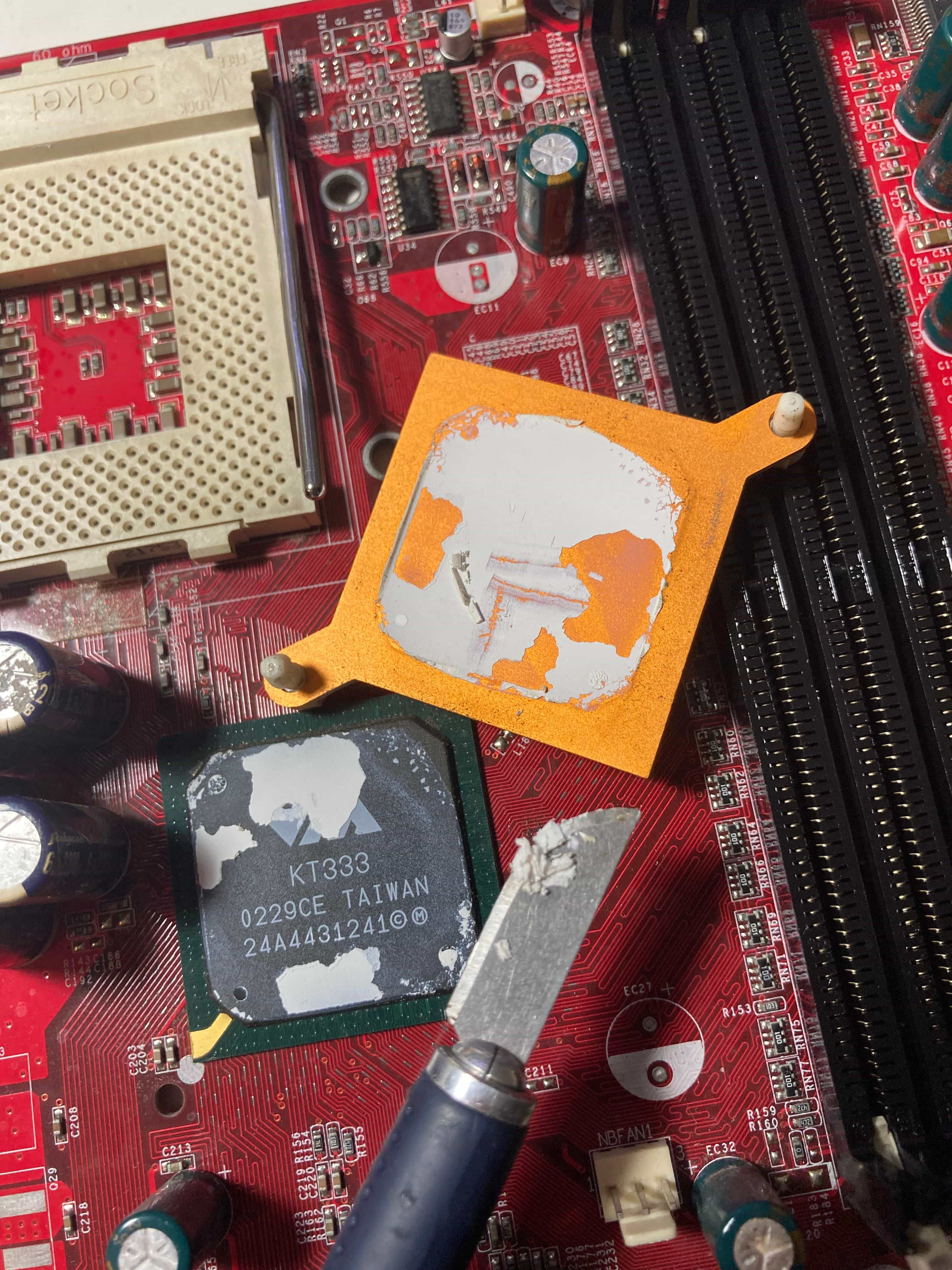
Time to bring about the lack of a rad GPU mentioned above. Some time earlier I was going through some stuff given to me (it would have gone to scrap had I not taken it) – nothing to write home about, save for one GPU that I recalled taking a pin header from to use in a Packard Bell I was restoring… wait a minute! It’s a Geforce3 Ti200!
The first time I laid my eyes on the card I paid zero attention to what it really was – in defense, that period of retro computing was not in my interest, let alone my scope of knowledge. Hence why it was mindlessly robbed of its pin header; in addition, the heatsink was deattached, and the cooling fan gone. It had all the looks of a dead, scrap-ready card. And yet, there it was – an actually very nice little card that would fit perfectly for a 2001-2002 era build.
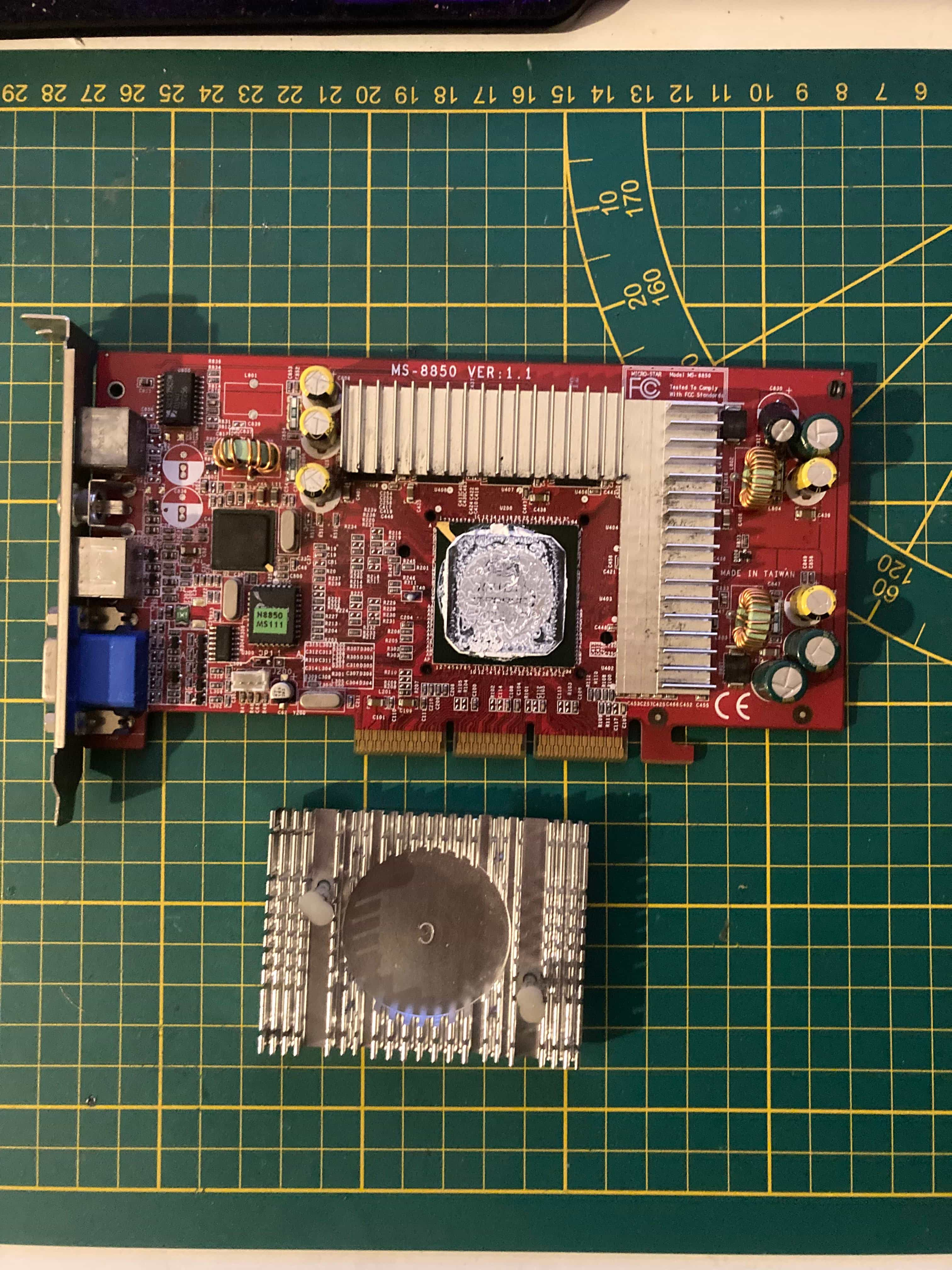
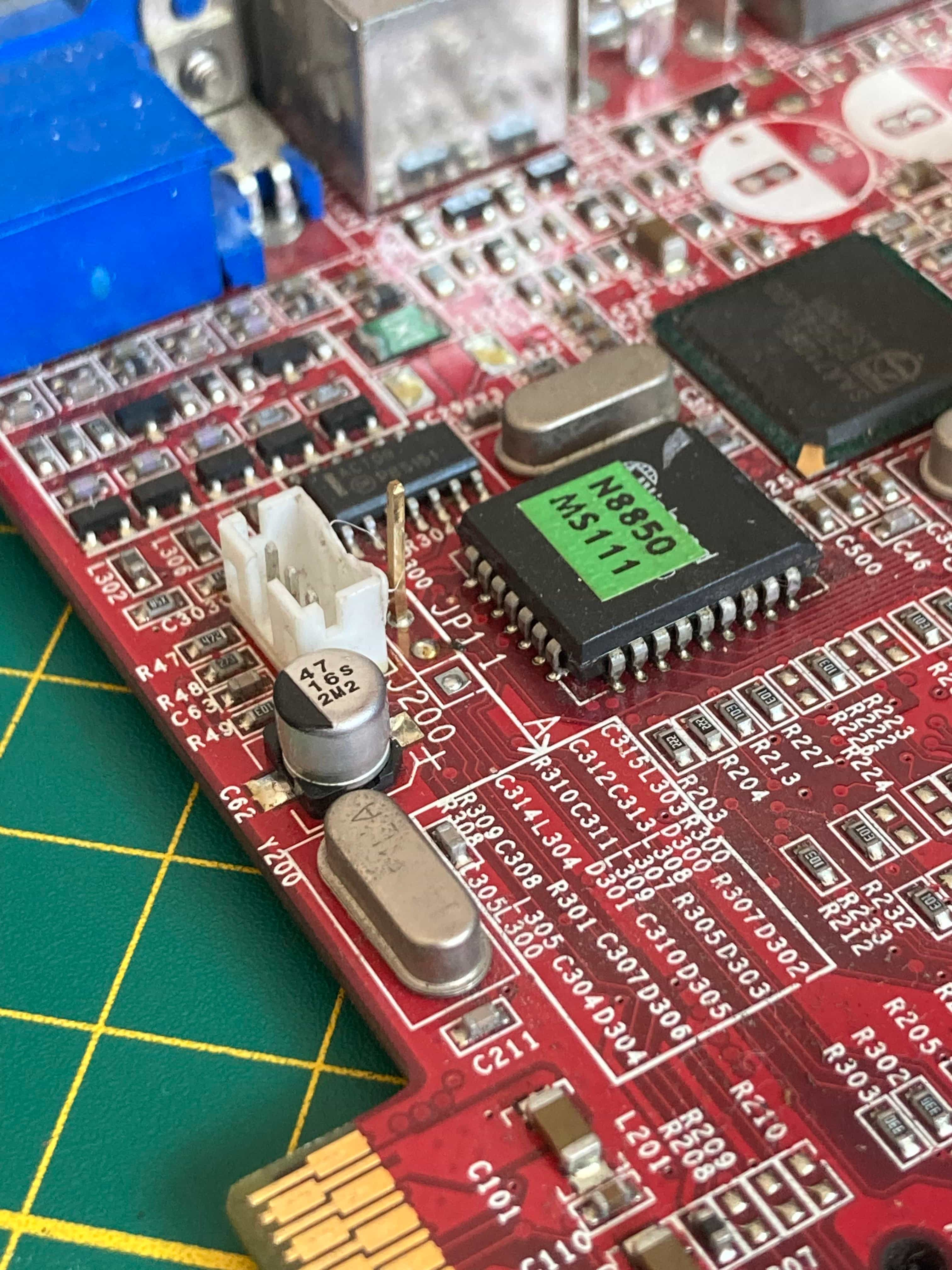
Those who know their GeForce cards of the era know that the Ti200 is a “refreshed” model, released in October 2001 along with the Ti500. The Ti200 is clocked lower than the regular GF3Ti (175MHz clock / 200MHz RAM vs. 200MHz clock / 230MHz RAM; the strongest Ti500 has 240MHz/250MHz clocks), however it makes up for it with overclocking potential (especially with those nice VRM heatsinks; only the fan situation has to be addressed) and the lesser-known fact that the “refreshed” models were also released with additional 64 megabytes of RAM for a total of 128MB… and this is one such card! The red color is the cherry on top – it will make for a whipass color-matched build, yo!
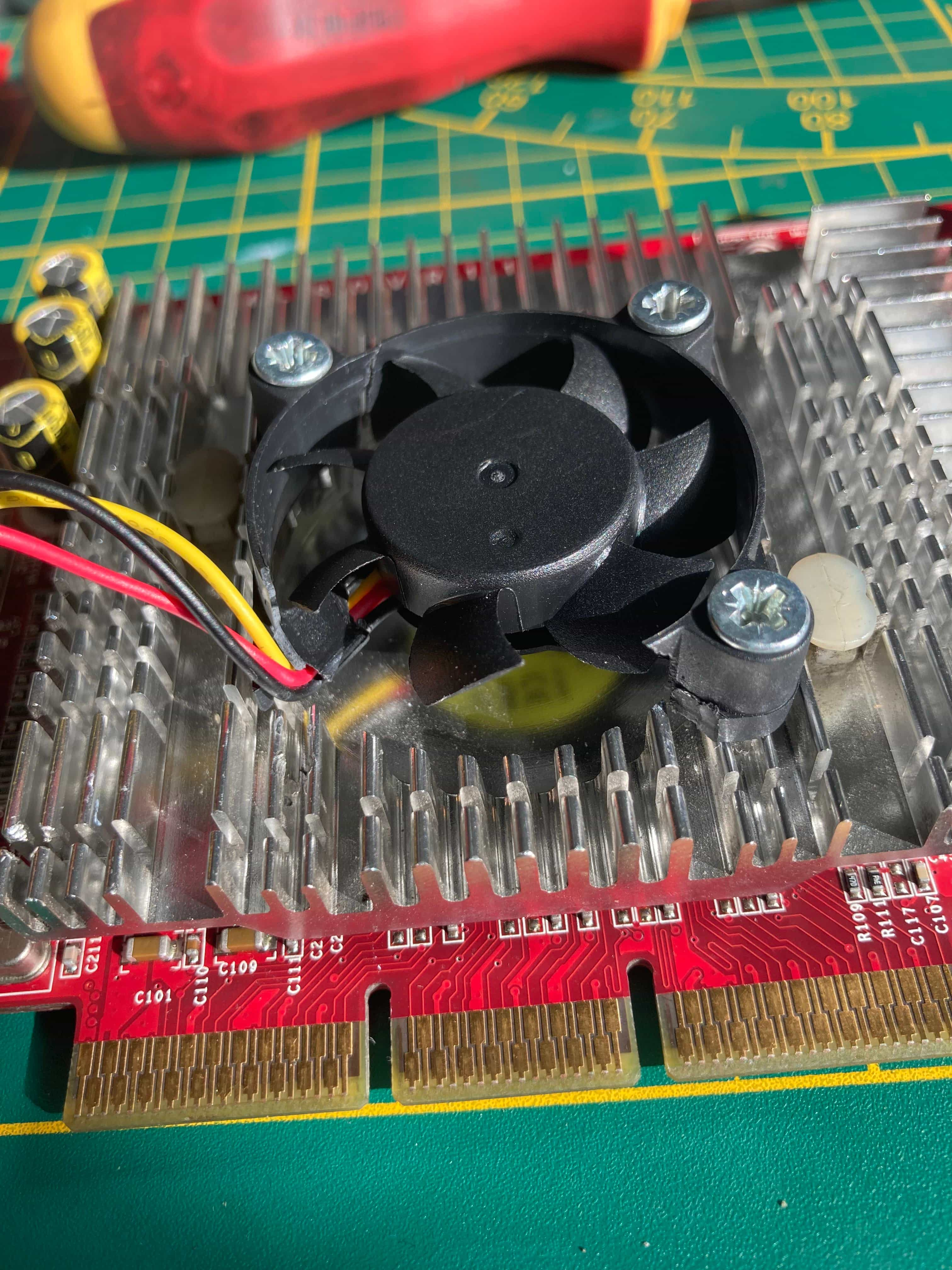
The missing header was resoldered, and a somewhat shoddy fan solution was devised – first I attached a 40mm PC fan with screws, but on the fourth one, the casing of the fan broke right at the hub. As is standard. So, I removed the casing, stuck some double-sided tape on the hub, and glued it right to the heatsink. It’s bad, but it will do until I figure out something better. Oh, and to nobody’s surprise, it POSTed just fine ;) although I think there was a cap on the top right side of the board replaced sometime in the past. On with the setup.
I went with Windows 2000 simply because it fits great into the build, and I spend much less time with the OS compared to other Windows releases, save for Me. The PC was super snappy, and I could feel the awesomeness by my left knee as it happily whirred its fans and crunched its hard drive. Content with the work done, my next step was to get some games on!
The build lasted a total of two days.
Technically, it didn’t last more than a few hours after installing Windows 2000 and setting up the games before the memory errors started popping up, hanging the system, and preventing the PC from booting. The D-Bracket sure helped as the buzzer didn’t beep at times. I found out that if I removed and re-inserted the RAM stick I’d have a roughly 50% chance that they’d disappear, but repeating such a procedure every time I used the computer is, well, suboptimal. I took a look at the slot itself – the pins inside the slot, as well as solder joints on the underside of the board – nothing was amiss. Later on, I figured that the board manual doesn’t list any support for the DDR-333 SDRAM stick installed. Replaced it with a supported DDR-266; no change. Hmm. The next weekend, when I was getting all ready to play some No One Lives Forever, the errors became much more frequent; what’s more, the D-Bracket began stopping on “System Power ON” and “Decompressing BIOS image to RAM for fast booting” statuses. It managed to boot into Windows a couple of times, but one could feel it wasn’t happy, and that any minute it could crap out. One moment, one freeze, and the PC would not post anymore, instead repeating the same 3 D-Bracket indicators to the tune of memory error piezo beeps.
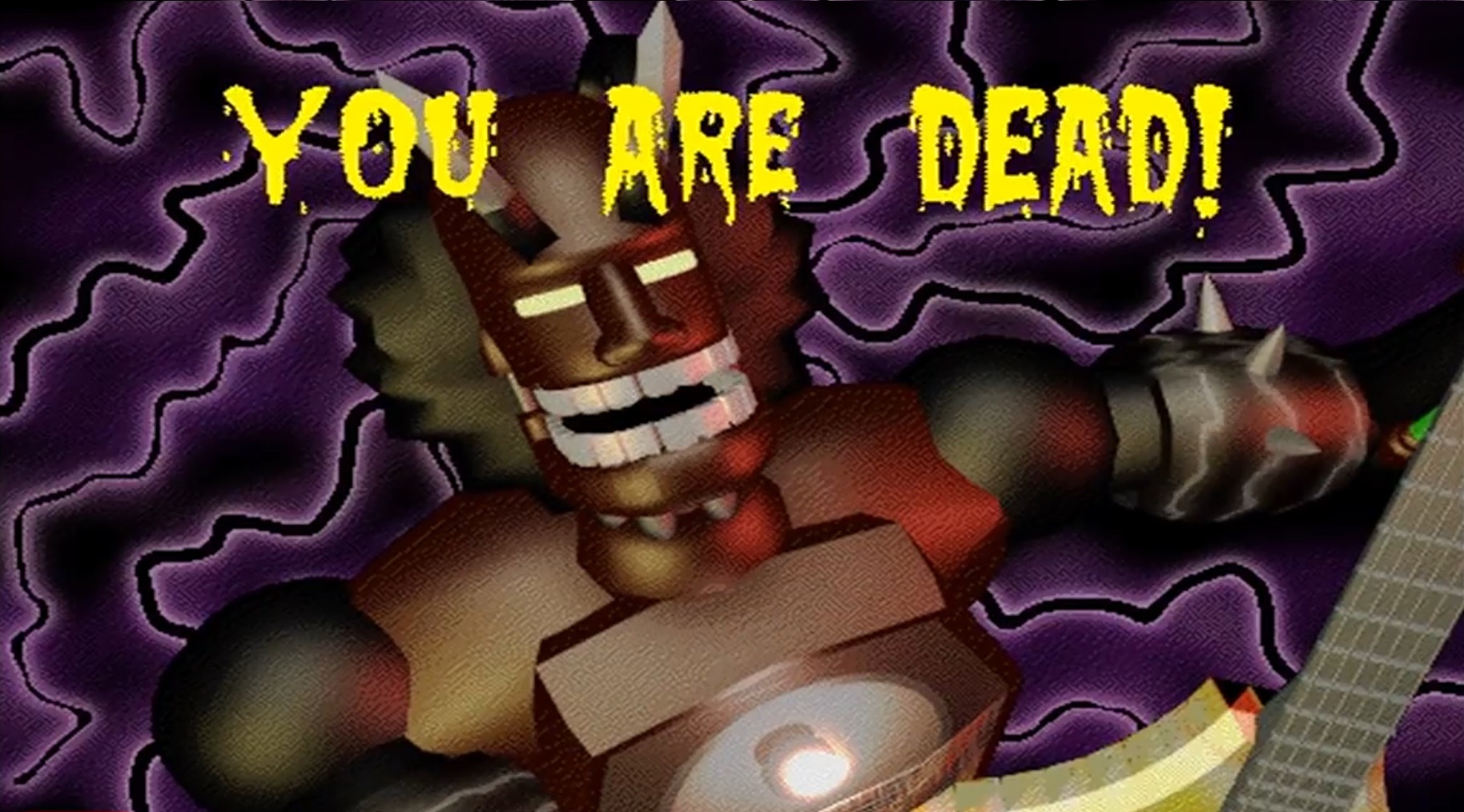
 in memory of
in memory of 
MSI KT3 Ultra
2002-2024